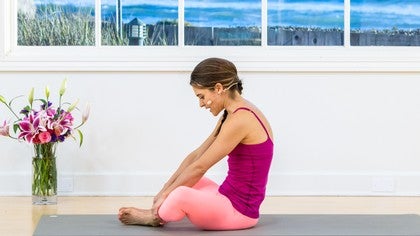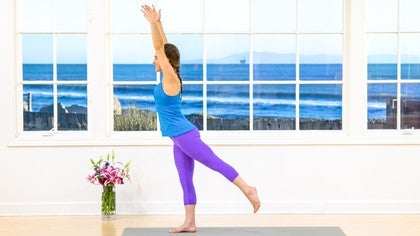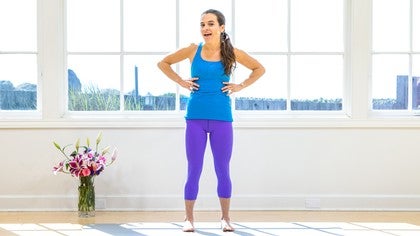Description
This lesson is designed to go along with Practice 3.
About This Video
Transcript
Read Full Transcript
Welcome to lesson three. So in our third practice together we begin to get an understanding of the rotation of our hips. So we're going to find this together just so that we're on the same page when we explore it in our practice. So come onto your back and then draw your right knee into your chest and just extend your right leg up to the sky. You might bring your hands on the back of the thigh. Now imagine deep within your right hip. There's a femur bone there. Begin to find and feel the external rotation. So it's like your foot's turning out like a duck. And then find the internal rotation, the opposite direction, also known as a pigeon toe. And then do that a few times. And you might even bring your right thumb into your hip crease and feel that external rotation, foot turning out. And then internal rotation, foot turning in. Okay, let's find that in reverse pigeon or eye of the needle. Find that external rotation, foot turning out, and then bring your right ankle across your left thigh. Good. And then send the knee away, let the hip open. Let's keep our right thumb into the hip crease. And then feel that, can you feel that external rotation through your hip? And then keep the thumb there as you draw the knee into the chest. We'll call this internal rotation. And then send the knee away towards that external rotation, like in a warrior two. And then internally rotate and externally rotate. Good. And then just release the right leg down. Let's just do that on the left side so that we're even. Draw the left knee in, extend the left leg up. You might support the back of the leg there. Bring your left thumb into the hip crease. Begin to feel and find that external rotation. And it might feel different on this side, right? The foot turns out like a duck. And then that internal rotation, more like a pigeon toe. Again, externally rotating from the very head of your femur bone in the hip joint. And you might even, as you find the internal rotation, bring your mind's eye into your left hip joint. Right? So you're initiating it from there, and then the foot follows. Good. Next time you come into that external rotation, the foot turns out like a duck. Bring your left ankle across your right thigh. You might keep your left thumb there as you open the hip, finding that external action.
And then rotate the knee into the chest, or draw it in, internally rotate. And then open the hip towards that external rotation. Send the knee away. And let's do this a few times together just so we're really clear on the actions here that will really serve us through the rest of our practice as we come to standing, and then sitting. Good. Come into that external rotation, and then lower the left foot down. Okay, let's make our way up towards a seat. And we'll find this action together with the soles of our feet together, knees wide. You might sit up on a blanket. Hands might find your shins or your ankles. And remember and listen to the bowl of water image. So begin to roll the pelvis forward like you're pouring the bowl of water forward, and then pour the bowl of water backwards as you come onto the sitting bones here. So as the pelvis rolls forward, notice how this feels through your hips. And as the tailbone curls under, notice how this feels through your hips. Again, roll the pelvis forward, so that bowl of water tipping forward, pouring forward. So this is an internal rotation. It naturally happens to the hips. And as you draw the tailbone under and roll towards the back of your sitting bones, the hips will naturally go into this external rotation. Do this a few times, rolling the pelvis forward. Notice what the internal rotation feels like. Naturally happens, and then rolling back, feeling that external rotation in your hips. Okay? So understanding this will help us throughout our practice, throughout all of our poses. Let's explore this together coming up to standing. Find your way up. Alright, let's look at our stance. So just go ahead and bring your feet out. Turn your feet out. Feel that external rotation through the hips. Just notice. And then internally rotate. And we're just sort of over-exaggerating here just to understand the point. Feeling that internal rotation like a pigeon toe. Okay? Let's look at this in like a wide leg forward fold. So we explore this in a handful of our practices. Bringing the feet wide. Now, generally feet are about parallel or feet turning in, heels wide. And what this does is it allows us to lengthen the spine, hinge at the hips, and the pelvis is rolling forward. So we're in that internal rotation through the thighs. Notice that if you turn your feet out, and I'll just demonstrate, it's hard to fold forward. Naturally in that external rotation, my body wants to move backwards. So it supports us in like a bridge pose or if we move into maybe a deeper back bend. Okay? So let's look at this in like a triangle pose. So we bring our feet wide. Let's bring our left foot and our right foot out. Notice how the left thigh is internally rotated. So there's that internal rotation through the hip. And then that external rotation through the right hip. So the thigh is like rolling externally. Okay? And then again, as we come into our warrior two with the right knee bent, that internal rotation and external rotation. So there's a lot happening here. So it's helpful to understand it on our backs or seated so that we can really, as we come up to standing, really begin to find some of these elements to support us. So a few other things we explore in our third practice together, oftentimes I'll say in a practice, breathe into where you feel the sensation or breathe into where you feel it. What is she talking about? What does this mean? And really it's an invitation to bring your mind, bring your attention and your breath into where you feel a stretch, where you feel a sensation. And the sensation might be somewhere in the physical body. It might be very obvious. Oh, it's my hip or oh, it's my shoulder or it's my neck, right? Perhaps it's a bit more subtle. Subtle meaning that which we can't quite see, right? Maybe it's a feeling in the body. Maybe it's an emotion you're working with. So the invitation is to breathe into where you feel it in the moment. And the idea is that the inhale helps to maybe create a bit more space or perspective. And then it's really our exhalation that can help kind of soften and release any tension in the body. And again, the tension might be physical tension, maybe in the shoulders, the hips, the spine. It might be emotional tension, something you may be holding onto and are ready to release through the practice. So another posture we explore in our third practice together is we start to get into some balancing. We look at a tree pose. And tree is where one leg is grounded, one hip is open in that external rotation. So it's requiring a lot of us. And so can we, as we come into tree pose, we're balancing on one leg, begin to find and feel some of those elements of mountain pose where we're grounded and stable as we come onto one leg. Another thing to pay attention to is where are you placing your gaze, your attention?
Are you looking down? Are you looking up? Are you looking to the side? For me, I find looking just kind of out in line with the heart or the horizon generally lends itself to a positive experience, whether I fall or not. Just allowing your gaze to be optimistic is very helpful. Another thing in tree pose or when you're working with balancing poses is to actually allow for that bit of wobbling and movement, which is actually really strengthening on the body. So allowing for that movement to happen as your gaze is focused and as you are concentrated, just allow for that movement. Like a tree, it naturally wants to move in the wind. So finding this quality of dynamic stillness as you come into your tree and paying attention to the quality of your breathing and the overall sense of ease in the body. So it requires effort to balance, to stand on both feet or to stand on one feet. So how can we begin to cultivate, develop, find a bit more ease within that concentration? And so your homework for this third lesson is to begin to explore some of these elements in the practice. So as you work through practice three, notice when your hips are internally rotated and externally rotated and notice what you choose to do. Notice what feels good for you in the moment and it might vary from one practice to the other. So in addition to your homework, begin to notice the quality of your breath as feedback as you move through your practice as well as the quality of your attention and the quality of your gaze. So I look forward to hearing from you. Let me know if you have any questions along the way. See you soon.







You need to be a subscriber to post a comment.
Please Log In or Create an Account to start your free trial.